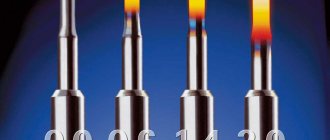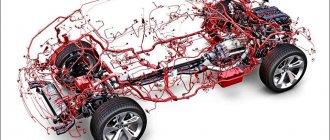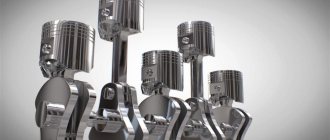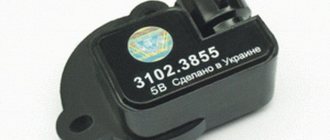Exhaust system design
The main task of the exhaust system is to effectively remove exhaust gases from the engine cylinders, reducing their toxicity and noise levels. Knowing what the exhaust system in a car consists of, you can better understand the principles of its operation and the causes of possible problems. The design of the standard exhaust system depends on the type of fuel used, as well as the applicable environmental standards. The exhaust system may consist of the following elements:
- Exhaust manifold - performs the function of removing gases and cooling (purging) the engine cylinders. It is made from heat-resistant materials, since the temperature of the exhaust gases varies on average from 700°C to 1000°C.
- The exhaust pipe is a complex-shaped pipe with flanges for attachment to the manifold or turbocharger.
- Catalytic converter (installed in gasoline engines of environmental standard Euro-2 and higher) - eliminates the most harmful components CH, NOx, CO from exhaust gases, converting them into water vapor, carbon dioxide and nitrogen.
- Flame arrestor - installed in vehicle exhaust systems instead of a catalyst or particulate filter (as a budget replacement). It is designed to reduce the energy and temperature of the gas flow leaving the exhaust manifold. Unlike a catalyst, it does not reduce the amount of toxic components in the exhaust gases, but only reduces the load on the mufflers.
- Lambda probe - serves to monitor the level of oxygen in the exhaust gases. The system may have one or two oxygen sensors. On modern engines (in-line) with a catalyst, 2 sensors are installed.
- Particulate filter (an essential part of the diesel engine exhaust system) - removes soot from exhaust gases. It can combine the functions of a catalyst.
- Resonator (pre-muffler) and main muffler - reduce the noise level of exhaust gases.
- Pipelines - connect the individual elements of the automotive exhaust system into a single system.
More active!
Is it possible to make engine life even more unbearable? Well, of course! It’s enough just to press the gas hard and we’ll “melt” the exhaust system even hotter, add load to the engine itself, and at the same time make the gearbox work well. Well, in order to finally get the tires and brakes to work, we’ll also actively work on the middle pedal.
However, we will not organize a race - we will simulate an “active” driver who drives in acceleration-deceleration mode, trying to get ahead of the entire flow between two traffic lights. We accelerate to 60 km/h, immediately brake, accelerate again - and drive in this style for just a few minutes. But this is enough for almost all the numbers to go up.
So, even during such a short trip, we immediately warmed up both the front brake discs (+64.1°C) and the rear drums (+53.1°C) by a good ten degrees, but at speed they already get some cooling by incoming air. The tires also warmed up a little (50.6°C / 46.3°C front and 45.9°C / 39.6°C rear). Although from my racing experience I know that these are tears: both brakes and tires heat up to much higher values during fast aggressive driving.
Now the engine has become noticeably heavier: at the outlet we get a record 321.1°C and 280°C, the block has warmed up to 84.9°C, despite the fact that the cooling system is already heavily loaded: on the thermostat module +79.8°C, on the expansion tank +86.9°C, even the radiator is warmed up to 73°C, although when driving it should cool much better. The intake manifold became even hotter (+62.2°C), and on the box body we measured 81.9°C. The difference in numbers seems small, but once again: we moved in this mode for only a few minutes. What if you attack harder and for a longer period of time?
The principle of operation of the exhaust system
In the classic version for gasoline engines, the exhaust system of a car works as follows:
- The engine exhaust valves open and exhaust gases with remaining unburned fuel are ejected from the cylinders.
- Gases from each cylinder enter the exhaust manifold, where they are combined into one stream.
- Through the exhaust pipe, exhaust gases from the exhaust manifold pass through the first lambda probe (oxygen sensor), which records the amount of oxygen in the exhaust. Based on this data, the electronic control unit adjusts the fuel supply and the composition of the air-fuel mixture.
- Next, the gases enter the catalyst, where they enter into a chemical reaction with oxidizing metals (platinum, palladium) and a reducing metal (rhodium). The operating temperature of the gases should not be lower than 300°C.
- At the outlet of the catalyst, the gases pass a second lambda probe, with the help of which the serviceability of the catalytic converter is assessed.
- Next, the purified exhaust gases enter the resonator and then into the muffler, where the exhaust flows are converted (narrowed, expanded, redirected, absorbed), which reduces the noise level.
- From the main muffler, exhaust gases already enter the atmosphere.
The diesel engine exhaust system has some features:
- Coming out of the cylinders, the exhaust gases enter the exhaust manifold. The temperature of diesel engine exhaust gases varies in the range of 500-700 °C.
- Then they enter the turbocharger, which performs supercharging.
- The exhaust then passes through the oxygen sensor and enters the particulate filter, which removes harmful components.
- Finally, the exhaust passes through the car muffler and is released into the atmosphere.
The evolution of the exhaust system is inextricably linked with the tightening of environmental standards for vehicle operation. For example, starting from the Euro-3 category, the installation of a catalyst and particulate filter for gasoline and diesel engines is mandatory, and replacing them with a flame arrester is considered a violation of the law.
Installing thermal tape
There are two technologies for installing thermal tape - wet and dry. Wet installation involves pre-soaking the tape in water so that it sits more tightly on the collector when heated and dried. The pipe is wrapped with tape with an overlap of 10-15 mm in one layer, and the edges of the tape are fastened with clamps. The surface of the commutator must be treated with heat-resistant paint before wrapping the commutator with tape. After installing the tape, it is also recommended to blow it out with thermal paint. It should be remembered that thermal tape is a consumable, disposable material and cannot be reused.
What is the temperature of the exhaust manifold?
Is it critical to control this parameter or at a similar pressure the mixture should not become critically lean with a live stock pump? Is it better to install - not to install a sensor “three hundred bucks is not extra…”? Last edited by FlyHol; 01/25/2006 at 14:29.
- 01/25/2006 14:31 #6 For 300 bucks you can check the mixture using a broadband lambda and if it’s poor, buy a fuel controller and adjust it... I would do that.
- 01/25/2006 15:16 #7 And then the air temperature changed, the quality of gasoline changed, the injector went haywire, etc. And we’ve already spent a lot of money to adjust the lambda once;) At least one of the critical parameters (and EGT is not the worst candidate) must be in front of your eyes constantly, and it’s better if with a warning.
How they checked
All measurements were taken on a Volkswagen Polo 1.6 MPI with a manual transmission. Each time, parts and assemblies were measured at the same points (in some cases, a shift of just a few centimeters gave completely different numbers). Each point was measured several times to ensure repeatability of the result. It was entered into the table.
Measurements were carried out using a non-contact thermometer HW600. At one time, we already explained why the figures obtained using such devices cannot be considered 100% reliable. All bodies emit radiation in the infrared range of electromagnetic waves. By measuring the power of this radiation, the surface temperature can be obtained. But different bodies have different emissivity. In a non-contact thermometer, the coefficient is set by the manufacturer and is unchanged, so an error of several degrees is inevitable. But this is if we measure the temperature of different objects. If we take the same surface, then as it warms up or cools down, we can record the difference in temperature, and this is exactly what we need!
Gasoline engine exhaust gas temperature in the manifold
Re: What is the temperature of the exhaust manifold? [Re: Bohdan75] August 19, 2015 at 4:40 pm Branches https://youtu.be/TmN_Q4YS55geverything turns red if you are very worried, wrap it as advised with thermal tape for release, you can hold on with your hand. 15 meters 2.5cm wide costs $40 Re: What is the temperature of the exhaust manifold? [Re: Bohdan75] August 20, 2015 at 08:10 Branches I don’t agree with the video. The car is tuned, and the fuel may also burn out in the muffler. The option of wrapping tape around the manifold or hoses is fine, you can also protect the hoses with fiberglass... But the question about the temperature of the exhaust gas is still interesting)) Re: What is the temperature of the exhaust manifold? [Re: Bohdan75] August 20, 2015 at 08:46 By branches And what exactly is the problem with looking at the temperature? A regular Bluetooth scanner ELM327 shows the lambda probe temperature parameter on most cars without any problems...
Area of application of thermal tape
Thermal tape is a bandage made of heat-resistant material, made in the form of a tape of a certain width. Used for thermal insulation of exhaust systems of sports cars and motorcycles. It looks brutal, so it fits into the framework of under-hood tuning; respectively, 2110 and 2109 automatically gain power with each roll of thermal tape on the exhaust manifold. Of course, the material was not invented for beauty, otherwise something more elegant could have been used. Initially, the purpose of thermal tape was:
Exhaust muffler temperature?
What is the temperature of the exhaust gases after the exhaust manifold of a diesel engine? A constant operating temperature allows you to receive signals from the sensor in a wider range of engine operating modes, which increases the overall purity of the vehicle's exhaust gases. Thanks to the advent of heated sensors independent of the ambient temperature, they began to use the installation of two oxygen sensors at once - before and after the catalyst. In this case, control of the amount of oxygen in the mixture is much more accurate, and the functioning of the entire exhaust system is more reliable.
In addition, this makes it easy to monitor the efficiency of the catalyst. One of the most famous manufacturers of oxygen sensors is the Japanese company Denso. The company introduced its first sensors in 1977, and over the years Denso has supplied hundreds of millions of its sensors to automotive manufacturers around the world.
Let's warm up
Today we're going to focus on the hardware. But why not, if there is such an opportunity, not look again at what temperature (approximately) the car interior warms up to on a hot day? The widget in the smartphone claims that it is +31°C outside, the car computer writes +34.5°C. It seems to be much cooler in the cabin, because we have air conditioning. Well, let's check it point by point.
The plastic panel and interior trim of the front roof pillars are heated to +28..+29°C, but all the finishing materials in the driver’s head area, that is, the headrest, ceiling, sun visor, give results from +32.8°C to + 34.6°C. This is quite a lot, because the head, as you know, should be kept cool.
Why do we feel fresh? Because no matter how you turn the deflectors away from you, they drive air in your direction. The plastic grilles themselves are cold - from +9°C to +11°C! And this once again comes to the question of why you need to use air conditioning or climate control carefully, choosing the right mode of operation.
Shock absorbers
Actually, these metals increase the cost of the exhaust system. Exhaust gases from the exhaust manifold enter the catalyst, in which, in contact with the surface of the honeycomb, carbon monoxide is converted into carbon dioxide, hydrocarbons into water and carbon dioxide, nitrogen oxide into water and nitrogen. The catalyst operates at exhaust gas temperatures from 200 Co to 800 Co. If the temperature is lower, then there will be no oxidation processes; if it is higher, the catalyst lattice will melt, which renders it unusable.
Worn out engines also damage the catalyst. In such cases, oil that enters and does not burn in the cylinders settles on the ceramic surfaces of the catalyst. Worn or inappropriate spark plugs for the engine, which do not ensure complete combustion of the fuel, will also shorten its service life.
Lead contained in gasoline, which accumulates on the walls of the ceramic coating, has a detrimental effect on them. In addition, to increase the service life of these elements, it is better not to use additives in fuel and motor oil if they still contain lead. On diesel engines, exhaust gases are purified by an unregulated oxidation catalyst. The reduction of harmful substances contained in such engines is achieved through a system of re-combustion of exhaust gases. Using a special valve installed in the exhaust system on a warm engine, part of the exhaust gases is directed into the engine cylinders, resulting in a reduction in the percentage of nitrogen oxides in the gases emitted into the atmosphere. It is also necessary to systematically monitor the condition of the spark plugs. The absence of a spark in one of the cylinders will lead to unburnt gasoline flowing into the exhaust system, which will negatively affect the condition of the catalyst. The catalytic converter can be destroyed by a single impact with a curb or protruding rock while driving over rough terrain. You should also be wary of sudden cooling of the catalyst, which can occur, for example, when a car crosses a deep puddle. Engine exhaust system Although in Russia this technology, due to a number of disadvantages, namely the high price, low freezing point of one of the main components of this technology, only -11.5 ° C, and increased requirements for the quality of diesel fuel, is used quite rarely.
Types of thermal tape
Like most parts purchased in our stores or online, thermal tape is divided into two large groups: good thermal tape and outright rubbish, for which unscrupulous thermal cloth sellers charge money. Such tapes burn out even at temperatures up to 500 degrees, otherwise you wouldn’t even dream about the smells they emit. Moreover, getting rid of the smell later is much more difficult than getting rid of thermal tape. Since the smell of burnt thermal tape of poor quality is not so widely advertised, few people are even aware of it.
In general, thermal tape is produced in different widths and colors. Bronze thermal tape is most often used on vehicles with higher manifold temperatures, while black and white are at the discretion of the buyer. You can also buy thermal paint along with thermal tape to give the part a more finished look. The thermal tape should be supplied with special metal clamps that hold the tape against the muffler or manifold.
Temperature - Exhaust Gas
The exhaust gas temperature in the engine cylinders of two-stroke gas engines and compressors ranges from 350 to 480 C, and in four-stroke gas engines at rated load from 510 to 520 C. [1]
The exhaust gas temperature should not be lower than 70 C. [3]
The exhaust gas temperature depends mainly on the same factors as the temperature at the end of the expansion process. Further depletion of the mixture leads to a decrease in the exhaust gas temperature, since, despite the increase in combustion duration, the maximum cycle temperature decreases. [4]
The temperature of the exhaust gases in an internal combustion engine is quite high, so the water vapor contained in them cannot condense and carries away the latent heat of vaporization. [5]
The exhaust gas temperature depends on the crankshaft speed, mixture composition, flame front propagation speed, ignition or injection timing and other factors. [7]
The exhaust gas temperature depends on the load and engine speed. With increasing speed and load, the exhaust gas temperature increases. [9]
The exhaust gas temperature is controlled by changing the amount of fuel supplied by both pumps of a given cylinder. In this case, you cannot cut down or move the stop installed on the pump rail when determining its flow on the stand. [eleven]
The temperature of the exhaust gases in the converters is increased by reducing heat loss by insulating the converter body, using special screens, using the heat of the oxidation reaction, and also briefly reducing the ignition timing. [12]
The most accurate determination of exhaust gas temperature can be performed using the calorimetric method. But its application under normal test conditions is quite difficult. [14]
Communities › Power Academy (tuning consultations) › Blog › Exhaust gas temperature
Good mood to everyone.
Today I installed a probe to measure the temperature of the exhaust gases. Diesel engine. I drove a little but the arrow did not move. He took off the probe and brought it to the lighter, the needle on the scale merrily crawled towards 300 degrees. This means everything is working properly. Can the exhaust really be so cold that the needle doesn't even move? Scale from 100 to 900 degrees. The photo shows the place where the probe was installed (there is a plug in the photo, I didn’t take a photo with the probe...)











